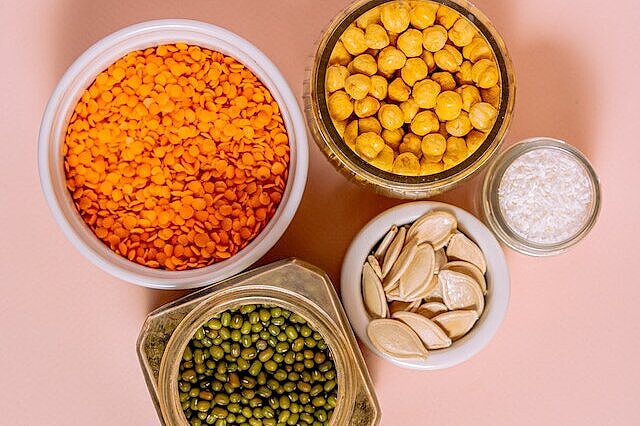Yellow peas

What are yellow peas?
Yellow peas are the dried and shelled seeds of the pea plant. They are one of the oldest cultivated plants in the world and are mainly grown in Asia, Europe and North America. Yellow peas have a yellowish color and a round shape. They can be processed whole or ground into flour.
Yellow peas have a high content of vegetable protein, fiber, vitamins and minerals. They also contain starch, which can serve as a source of carbohydrates for dogs. Yellow peas are gluten-free and can therefore be an alternative for dogs with gluten intolerance.
What are the benefits of yellow peas for dogs?
Yellow peas, when fed in moderation, can have some benefits for a dog's health. For example, they can
- aid digestion: The fiber contained in yellow peas can stimulate bowel movements and prevent constipation. They can also increase the feeling of satiety and prevent obesity.
- They strengthen the immune system: The vitamins and minerals in yellow peas can strengthen the immune system and ward off infections.
- Build muscle: The plant-based protein in yellow peas can help build and recover muscle. It can also improve skin and coat health.
What are the disadvantages of yellow peas for dogs?
Yellow peas are not suitable for all dogs and can also have some disadvantages. For example, they can
- Trigger allergies: Some dogs can have an allergic reaction to yellow peas or other legumes. Symptoms can include itching, skin rash, diarrhea or vomiting.
- Cause flatulence: Yellow peas contain antinutrients such as lectins and phytic acid, which can inhibit digestive enzymes and cause gas. This can lead to bloating, abdominal pain or burping in your dog.
- Nutritional needs not met: Although yellow peas are a good source of protein, they do not contain all the essential amino acids your dog needs. They can also bind other nutrients such as taurine or zinc and reduce their absorption. You should therefore not use yellow peas as your dog's only source of protein.
How much yellow peas can my dog eat?
The amount of yellow peas you can give your dog depends on various factors such as age, size, activity level and health status. In general, however, yellow peas should only make up a small part of your dog's daily calorie intake.
If you give your dog a ready-made yellow pea food, you should make sure that it is balanced and contains all the nutrients your dog needs. You should also follow the manufacturer's feeding recommendations and adjust the amount of food to your dog's needs.
Yellow peas are dried and shelled seeds of the pea plant. They are rich in vegetable protein, fiber, vitamins and minerals. In moderation, they can aid digestion, strengthen the immune system and help build muscle. However, they can trigger allergic reactions, cause flatulence and do not meet all of a dog's nutritional needs. The amount of yellow peas a dog can eat depends on various factors and should be integrated into the dog's daily calorie intake.
Properties 7
Are you looking for other ingredients with a specific property?
Just click on them to find more.
If you notice any signs of hypersensitivity or poisoning in your dog, you should see your vet immediately. We are not a substitute for a vet, but we try to be as accurate as possible. Every dog reacts differently and we recommend you get a second opinion or consult your vet if in doubt.
Stay healthy and take good care of your four-legged friend!😊
Similar to Yellow peas
There are different types of peas that you can give your dog, such as Green peas: These are the classic peas that you can buy fresh, frozen or dried. They are safe for dogs as long as they are not...
The short answer is yes, but only cooked and in moderation. When raw, chickpeas contain the toxic substance phasin, which causes the red blood cells to clump together and can lead to diarrhea,...
Lentils are the seeds of plants from the papilionaceous family. There are different varieties of lentils, which differ in shape, color and taste. The best known are red, green and brown lentils....
Mung beans belong to the papilionaceous family and originally come from India. They have been cultivated for over 4000 years and are an important part of the diet in many countries. Mung beans have...



